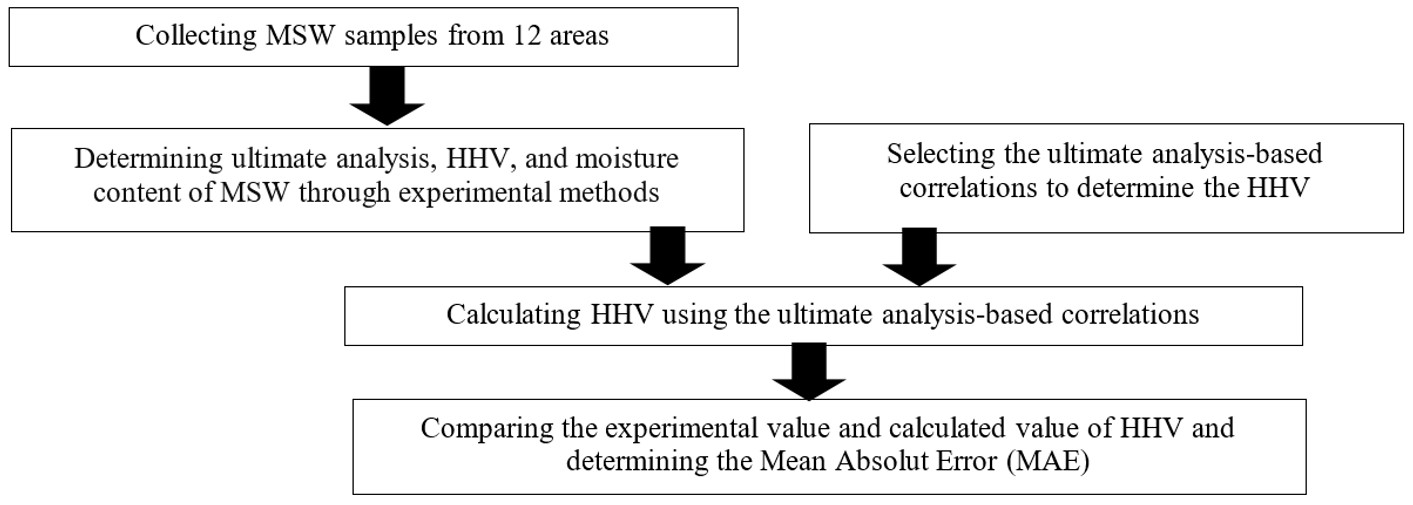In-Depth Analysis of Municipal Solid Waste's Heating Value for Green and Clean Renewable Energy in the context of Way of Live
Main Article Content
Abstract
The increase in global waste levels and the decrease in fossil energy sources are major concerns around the world. Waste-to-Energy (WtE) technologies have been used to transform Municipal Solid Waste (MSW) into energy and minimize concerns about global waste levels and fossil energy. However, MSW presents a number of challenges when used as a feedstock for energy production due to its heterogeneous composition, low energy content, and high moisture. To design waste incineration power plants, it is necessary to measure the Higher Heating Value (HHV) and the composition characteristics of MSW. Therefore, this paper proposes a most suitable correlations based on ultimate analysis to accurately estimate the HHV of MSW. The correlations consider all parameters that influence the HHV of MSW. MSW was collected from both urban and rural areas. Ultimate analysis was performed to characterize the chemical composition of MSW from both areas, and the HHV was also determined to compare the differences in the chemical properties of MSW from different areas. This work helps save experimentation costs and assists in the design and management of waste incineration plants.
Article Details

This work is licensed under a Creative Commons Attribution-NonCommercial-ShareAlike 4.0 International License.
This work is licensed under a Creative Commons Attribution-NonCommercial-ShareAlike 4.0 International License.
References
World Bank. What a waste 2.0: a global snapshot of solid waste management to 2050. Trends in solid waste management [Internet]. 2023 [cited 2023 Aug 15]. Available form: https://datatopics. worldbank.org/what-a-waste/trends_in_solid_waste_management.html.
World Bank. Decision makers’ guide to municipal solid waste incineration [Internet]. 2023 [cited 2023 Aug 15]. Available form: http://documents.worldbank.org/curated/en/206371468740203078/ Municipal-solid-waste-incineration-a-decision-makers-guide.
Janna H, Abbas MD, Al-Khuzaie MM, Al-Ansari N. Energy content estimation of municipal solid waste by physical composition in Al-Diwaniyah City, Iraq. J Ecol Eng. 2021;22(7):11-19.
Fetene Y. Characterization and heating value prediction of municipal solid waste. Int J Environ Agric Res. 2021;7(1):14-23.
Olatunji O, Akinlabi S, Madushele N, Adedeji PA. Estimation of municipal solid waste (MSW) combustion enthalpy for energy recovery. EAI Endorsed Transactions on Energy Web. 2016;6(23):34-37.
Khuriati A, Budi WS, Nur M, Istadi I, Suwoto G. Modeling of heating value of municipal solid waste based on ultimate analysis using multiple stepwise regresion linear in Semarang. ARPN J Eng Appl Sci. 2017;12(9):2870-2876.
Gunamantha M. Prediction of higher heating value bioorganic fraction of municipal solid waste from proximate analysis data. Int J Eng Res Technol. 2016;5(2):442-447.
Shi H, Mahinpey N, Aqsha A, Silbermann R. Characterization thermochemical conversion studies and heating value modeling of municipal solid waste. Waste Manag. 2016;48:34-47.
Zhu X, Yang G. Study on HHV prediction of municipal solid wastes: a machine learning approach. Int J Energy Res. 2022;46(3):3663-3673.
Nzihou JF, Hamidou S, Bouda M, Koulidiati J, Segda BG. Using Dulong and Vandralek formulas to estimate the calorific heating value of a household waste model. Int J Sci Eng Res. 2014;5(1):1878-1883.
Yin CY. Prediction of higher heating values of biomass from proximate and ultimate analyses. Fuel. 2011;90(3):1128-1132.
Nguyen KLP, Chuang YH, Chen HW, Chang CC. Impacts of socioeconomic changes on municipal solid waste characteristics in Taiwan. Resour Conserv Recy. 2020;161:104931.



